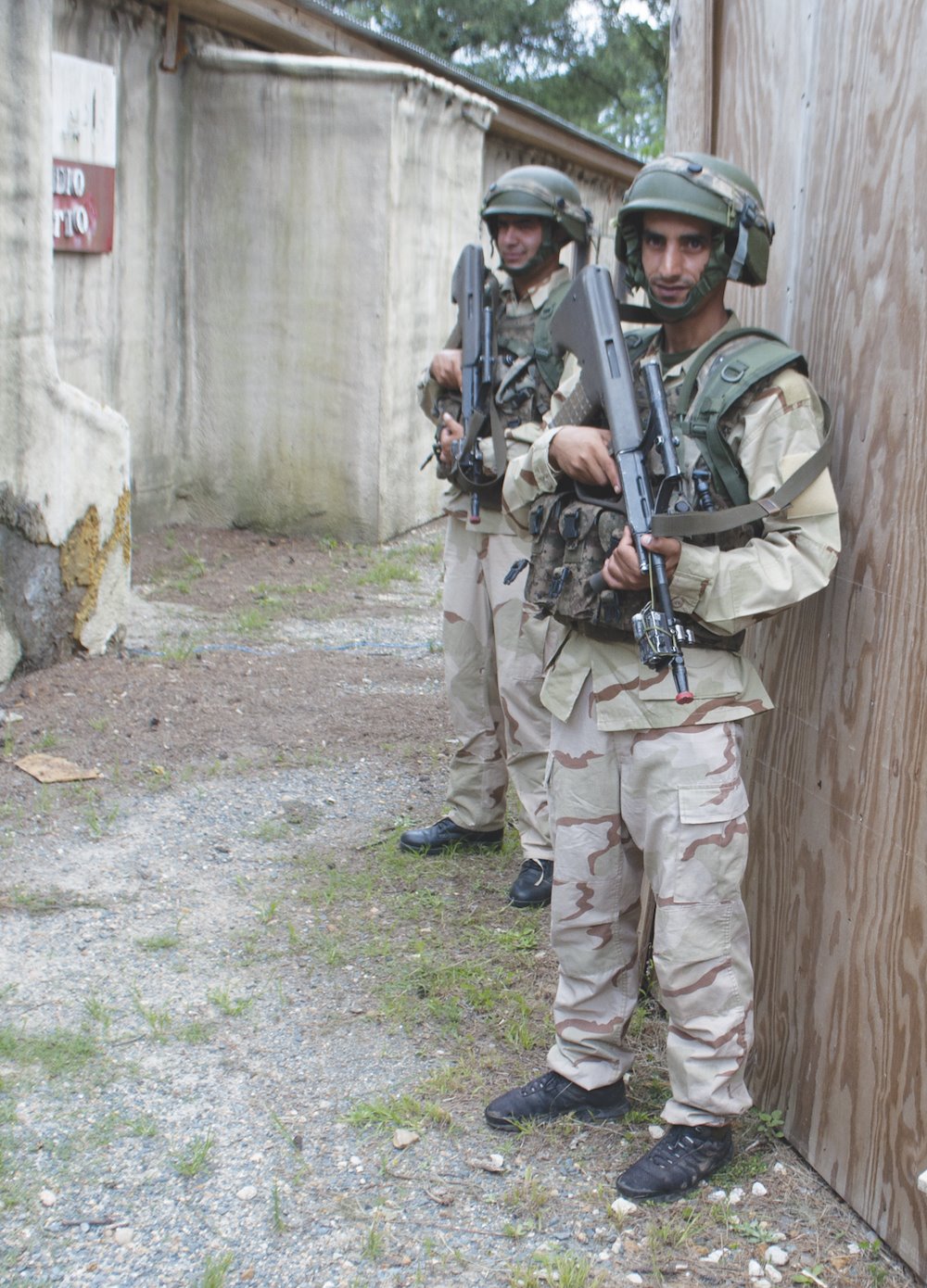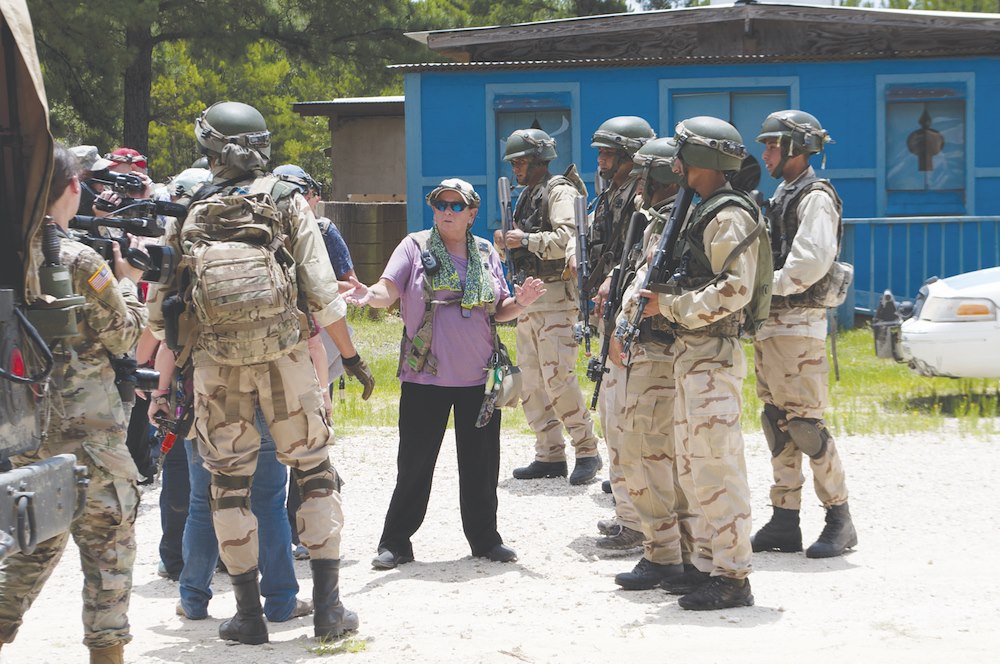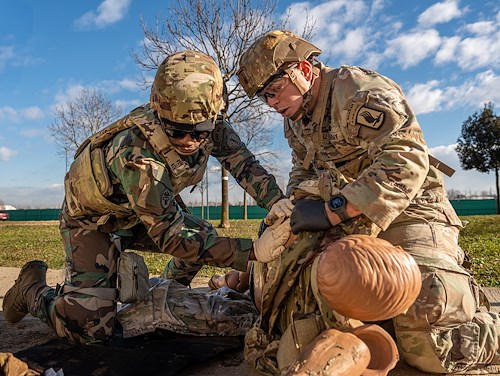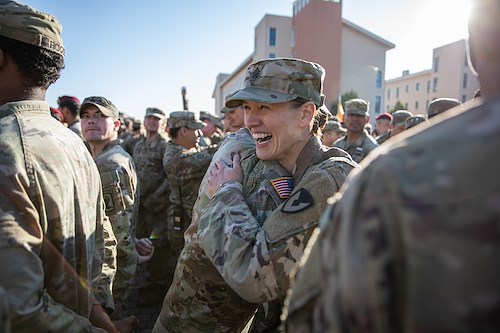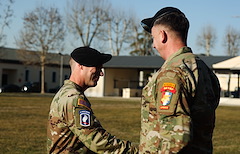Gallery contains 2 images
×
Photo 1 of 2
JRTC hosts Tunisian army for training
Members of the Tunisian Armed forces are tested during an exercise in a simulated village. In the scenario, trainees faced an angry crowd of role-playing villagers and assisted the local police force at the Fort Polk Joint Readiness Training Center, June 25.
Photo by: Patricia Dubiel
Photo 2 of 2
JRTC hosts Tunisian army for training
The Tunisian army is tested during an exercise scenario in Turani village. The trainees faced an angry crowd of villagers and assisted the local police force in a arresting a local mayor on charges of corruption at fort Polk Joint Readiness Training Center, June 25.
Photo by: Patricia Dubiel
In real world missions, the U.S. Army often pairs with other armies to achieve common goals, so it stands to reason that the JRTC, serving as both a training and testing ground, welcomes opportunities to offer its services to partner nations. In doing so, the guest army gets world-class training and the JRTC gains experience to further enhance future rotations and joint missions.
For rotation 18-08, one of the units came all the way from Tunisia to participate. Last year, a small contingent of Tunisians served as the host nation force battalion staff, learning about the technology and methods used in tactical operations centers. This year, the group was larger — 124 personnel — 99 of which served in an infantry role, and the rest making up the battalion staff.
“We have had the Tunisians with us before, and they brought a phenomenal staff element that worked with our units,” said Col. David Doyle, commander, JRTC Operations Group. “For us to see them bringing a full (company) now, shows that their organization is becoming more engaged with larger-scale operations, and that’s one of the things we’re trying to do — increase the complexities for the (brigade combat teams) that come here to train. They have to be familiar not just with working with small international groups, but also battalion or larger elements. So this is a great change for a BCT to see what an international partner does with more forces on the ground. We are very fortunate to have them here.”
Maj. Matt Etheridge, 2nd Battalion, 22nd Infantry Regiment from Fort Drum, N.Y., is the advisor to the Tunisian commander. He said the group training at JRTC consists of soldiers that have never worked together before, and they are challenged to not only work together, but also with American Soldiers and to learn something from the experience.
“The platoons are from different locations (in Tunisia) and they came together to form a company, then integrated with the handful of guys we brought in from Fort Drum for this rotation,” Etheridge said. “Their ability to integrate is probably better than some U.S. units I’ve seen forming ad hoc organizations. I am impressed. We have seen dramatic improvements, not just in processes but also in how quickly they can form a good team. They have done very well.”
Etheridge explained what the Tunisians will accomplish during the rotation.
“There is a three-fold objective for the Tunisians training here,” he said. “One is tactical (proficiency), the second is training up their (observer-controller-trainers) so they can take those skills back to their version of JRTC, and the third is improving staff operations. They seem pretty happy with how training is going in all three of these objectives.”
On the tactical side, there has been a particular focus on soldier tasks — with an infantry focus — according to Staff Sgt. Christopher Bober, an OCT with A Company, 3rd Battalion, 353rd Armor Regiment, JRTC Operations Group.
“We have done a lot of infantry training, individual soldier discipline, battle drills like entering and clearing buildings and how to maneuver between them, and patrol based operations,” said Bober.
“They have been doing very well. They have absolutely surpassed any expectations by leaps and bounds. They are always motivated — especially platoon leadership. One phenomenal improvement that they have made is incorporating NCOs throughout their formation, which is something they do not usually do.”
Sgt. 1st Class Steven White, advisor, D Company, 2nd Bn, 22nd Inf Reg, explained how some of the tactical exercises are planned.
“They (the Tunisians) set the goals for training and we help (facilitate) that,” he said. “We look at some of the tactics and techniques that they use in their home country to fight the threat they encounter there, and we, as advisors, look at how we can help them become more lethal in that endeavor. We don’t try to make them do things the way we do, but rather show them the science of why we do what we do, then build upon the way they do things.”
The use of OCTs is a new concept for the Tunisians, and they want to begin incorporating them during their home-station training. For rotation 18-08, that means applying a train-the-trainer concept.
The Tunisians OCTs are paired with U.S. OCTs to compare notes and learn about the OCT role.
“Learning this way is a big benefit to us so we can improve our techniques — how to observe, coach and advise,” said Capt. Saleh Ben Abdellah, Tunisian OCT.
“The take away for the OCT training is how to make the staff understand their weakness and flaws (respectfully) — it’s not so easy because this is new, but we accept it,” he said. “My role here is to see how the Tunisian (staff) run the command post and how they do their work — how they plan and instruct the soldiers to carry out the missions. I have learned a great deal.”
But it’s not just the Tunisian OCTs getting practical experience from this rotation.
“It’s also good for our (U.S. Army) advisors, to get that practical exercise in working with a different nation’s military and learning how to facilitate training for them,” said White. “Being an advisor means having a skill set that not a lot of people have, and if you don’t do it often, you may forget things.”
Bober agreed. “It’s not just us teaching them — I’ve learned a lot too,” he said. “It’s been a good experience on both sides.”
Doyle said that while the 3rd Bn, 353rd Armor Reg OCTs do this for a living, it’s still a good experience.
“They work with all the partners from the Middle East. That means we will be able to compliment the Tunisian force with specific OCTs who have this as their day job, while the rest watch and learn how the BCT makes decisions in interacting with an international partner,” said Doyle. “So that’s great for the OCTs.”
Etheridge said the JRTC is also gaining a deeper understanding about facilitating training for future exercises.
“It’s a unique experience for JRTC as well. We’re learning a lot about how to make this an even better experience next time, and it’s good for us to be exposed to another nation’s army and see how they operate,” he said. “This experience has spurred dialogue between the U.S. and Tunisia about the next time we do this. All indicators point to the Tunisians being excited about continuing this relationship and to ramp up their OCT training.”
Tunisian leadership is also getting something out of the training, said Etheridge. “They get the experience of being either a staff, commander or platoon leader here at JRTC, but more than that, they get the experience of what JRTC is. I think a lot of them came in thinking it was going to be similar to the training they’ve done, with a lot of (situations training exercises) lanes. Here they have a force-on-force replicated near peer threat,” he said. “It surprised a lot of them when we started explaining what to expect, but they have jumped right in, embraced it and gotten a lot better for it. Hopefully they will take that back to Tunisia and incorporate that realism into their version of JRTC.”
Lt. Col. Anis Lamouchi, the G3 (training) of the Tunisian army, said working with the Americans has been beneficial.
“We have similar training in our country, but the new thing here is learning how to work with another army. This has been a challenge,” he said. “We learned a lot from this experience. The most important thing for me has been learning how to analyze the tactical situation using the military decision making process model.”
For 1st Lt. Soltani Moudhaffer, one of three platoon leaders here for the rotation, the exercise has been eye opening.
“It’s really been interesting to train at the JRTC because the facilities and role players gives reality to the training, as does having a well-trained enemy. This has been good,” he said. “We have learned a lot from the U.S. Army — new methods and skills — but it’s been good that we got to see their way of working. The U.S. Army is very professional. I want to include some of the skills that we have learned here in a training program back home to teach other soldiers.”
White said this rotation also gives the Tunisians a look at a different side of the U.S. Army.
“This kind of training gives the Tunisians a better understanding of what our regular Army does,” he said. “Historically, they’ve only had special operations groups work with them, so here is an opportunity for them to see how we conduct training.”
Brig. Gen. Patrick D. Frank, commanding general of JRTC and Fort Polk, said having the Tunisians here for a rotation is an enormous opportunity for everyone involved to gain valuable experience.
“Having our allies, the Tunisians, here at JRTC gives us a chance to show them how the American Army trains at one of our combat training centers. We will give them exceptional training while they are here,” said Frank. “What the 2nd Brigade, 10th Mountain Division (the rotational unit paired with the Tunisians for the exercise) gets out of the training is real coordination with our allies on a decisive action battlefield. That’s a phenomenal training enabler for them in this rotation. You don’t get that at home station, you only get that at a training center, and that’s why we provide that type of opportunity.”



